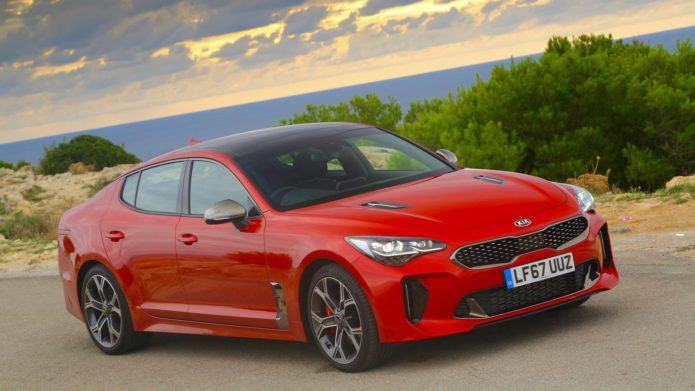Say it slowly: K-i-a Sting-er G-T. Nope, it still sounds funny.
Excuse us for poking fun at a name, but can you imagine walking into a party and saying to someone: “Yes, I drive a Kia Stinger GT”? It makes you sound like you’ve just walked off the set of Top Gun (younger readers, Google is your friend here – although the sequel is supposedly coming). Cheesy though that might be, maybe it’s not such a bad thing. After all, Maverick and Goose were pretty cool (we might’ve said rad when it came out, who knows).
And ‘maverick’ is a word that’s appropriate for the Kia Stinger GT – sampled here in its top-of-the-line V6-engine ‘S’ format – as this is Kia taking on the world. Or, more specifically, taking on the German premium brands.
That’s a mark of the just how far Kia has come. For a brand that was unheard of just 30 years ago, it’s now arguably overtaking European staple brands like Ford and Vauxhall. And the Stinger GT can stand toe-to-toe with BMW, Audi and Mercedes. The question is: do you prefer spicy kimchi or pickled sauerkraut?
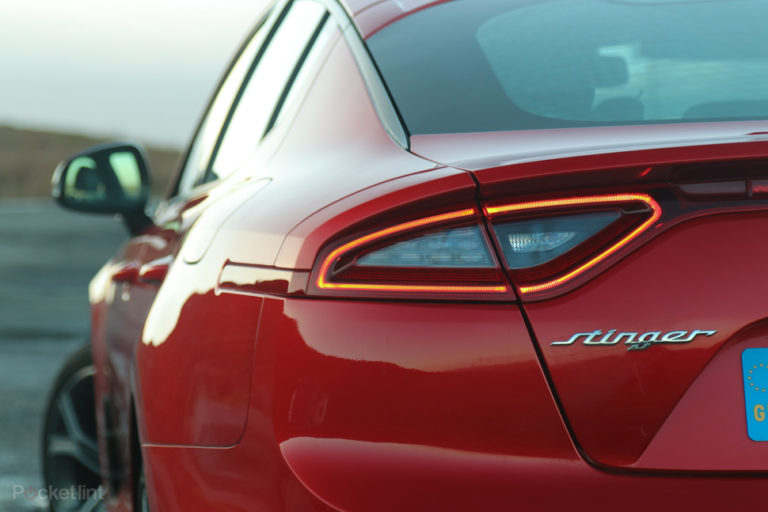
Another smash-hit design
First impressions are pretty good. This is another smash-hit Korean design, conceived in the firm’s German design studio, by guys who used to work for Audi and the rest.
The Stinger is what’s known in the car-industry as a 4-door coupe. It riffs of the Mercedes CLS, providing a sporty roofline (like a coupe) but with the practicality benefits of a 4-door saloon.
At 4.8 metres long, it’s big. Bigger than a BMW 3 Series or Audi A4, but a little shorter than a 5 Series or A6. Its closest rivals are arguably the Audi A5 Sportback and BMW 4 Series Gran Coupe. But even then, the Kia is slightly bigger than each of those, and compared spec for spec it’s quite a bit cheaper.
The Stinger’s proposition is quite simple: are you prepared to trade in the keys for your German premium car, its small diesel engine and miserly standard equipment, for the bigger and much better equipped Kia? On that suggestion alone, you’d have to say you would.
Whereas a 4-Series or A5 Sportback is handsome, they’ve become such common sits on the road that you barely blink twice. And to make them look right, you need to spend extra – on the M-sport/S-Line trim equivalents, the optional big wheels and a nice shade of metallic paint will cost you dear – whereas our Stinger GT S looks as pictured from the off, for £40,535. The only option added to our test car is the Hi-chroma red metallic paint (at £645).
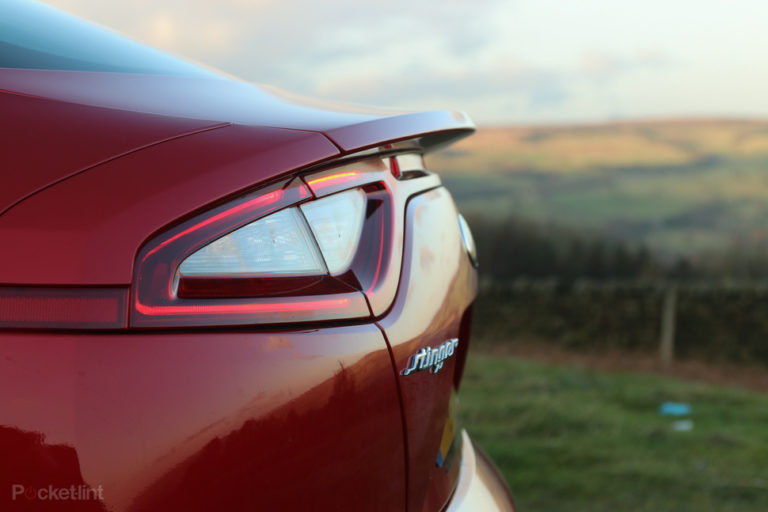
Everything is standard
Honestly, everything else you see in our pictures and that we’re about to write about is standard spec. On this top-line model, your options choice are limited to paint colour and a few odd accessories. Yes, you might gripe about spending £40K on a Kia. But before you dismiss it, it’s worth scrutinising the spec sheet and doing a little comparison work.
You get 19-inch diamond turned alloy wheels, LED headlamps, a pixel grille, Nappa leather heated/cooled electrically adjustable seats, a head-up display (HUD), paddle shifters, powered boot-lid, adaptive cruise control, high-beam assist, autonomous emergency braking, a blind spot warning system, a 360 degree smart view camera, a 15-speaker Harmon/Kardon stereo, a Qi wireless charging pad, an 8-inch touchscreen with Navigation (and TomTom provided traffic and camera info), and Apple CarPlay and Android Auto.
While we are testing the top model here, most of these things are standard across the range. So you really do get a bang for your buck with this car.
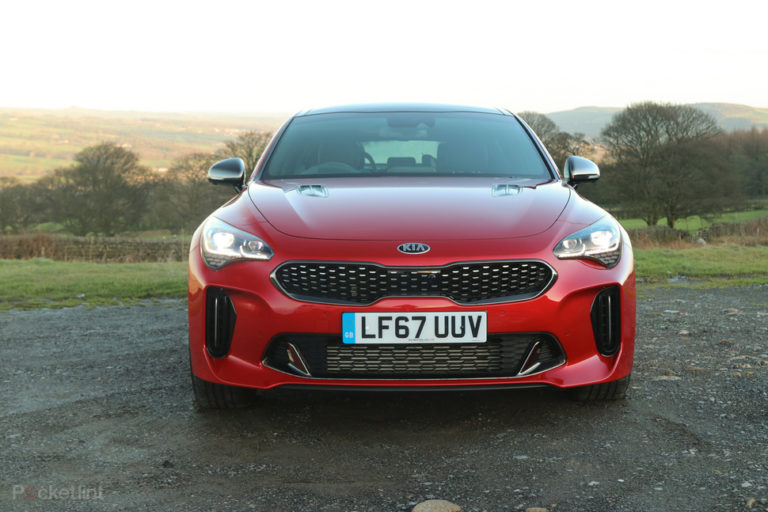
Size isn’t everything
But size isn’t everything. Emissions matter too. Yes, you could buy a 2.2 diesel Stinger GT, and probably should, because it starts at around £33K and produces 154g CO2/km, which means you’d get a nice company car with loads more equipment than if you buy German.
However, that’s not what we’re testing here. The GT S has a 3.3-litre V6 engine, makes 365bhp and kicks out a rather embarrassing 225g CO2/km. Which means unless you’ve opted out of your company car scheme then it’s never going to make sense as you’ll be taxed to death.
However, if you are buying privately, the GT S is a very fun to drive car indeed. Obviously, 365bhp is rather a lot, and the Kia puts its power to the road through the rear wheels and an 8-speed auto box. It’s almost amusing to drive as a result.
On startup it makes a rather nice noise, with a bit of a high-rev flourish, then emitting a neat growl as you power down the road. And power you do, the nose of the car hoisting up and the rear feeling like it squirms a bit as you apply all that power. It never feels uncontrolled, more like you’re piloting a rather well-endowed power boat (which during our rainy test week is what it felt like).

No respect for rules
Find some bends and you’ll discover that the Kia – which isn’t the lightest car on its feet – has been setup by some people who clearly enjoy driving and don’t care so much for the generally well-established rules of play.
Rules like “when the stability control is switched on, don’t let people go quite a bit sideways before helping them out”. But this is exactly what the Stinger GT S’s system lets you do. What’s more you can switch the system off, at which point you can just drive the Kia sideways, in a slightly messy way, for as long as you choose (or are able).
It made us smile, then it made us laugh. And then we found a big empty car park and (safely, we might add) indulged in some borderline hooligan behaviour. Because it’s good for the soul. And because there are so few cars that let you do this kind of stuff, in 2018.
Back in the real world for a moment though. The Kia’s steering is a little bit dead feeling, the ride a tad lumpy, and we only achieved 19mpg. But are you surprised? It’s a GT S.
What does work, however, is long distance cruises, where the Stinger happily ploughs along motorways quite serenely. In fact, it’s more refined than the last BMW 4 series we drove.
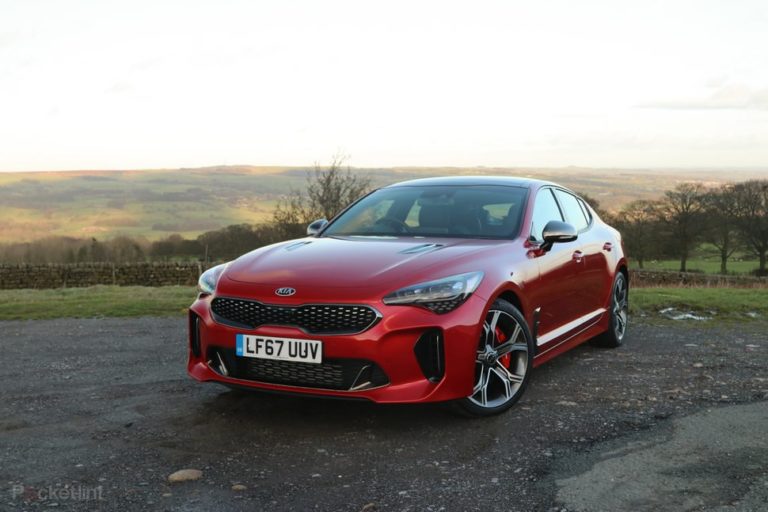
The (not so) cheap seats
It’s inside the Kia where you’ll perhaps notice the real differences if you’re stepping out of, say, an Audi. And we don’t mean that in a good way.
The interior design isn’t anything to write home about. Despite some nice chrome-ringed air vents and leather-covered dashboard, the metal effect trims look cheap, the radii are large and a little clunky, and it’s all fairly plain and free of thrills.
Yet there’s no denying that it all works, it’s easy to use and there’s plenty of space – including well proportioned, comfortable front seats, decent room in the back, and a big boot.
Still, this interior is where the Kia feels furthest away from the premium standard set by the German brands – and that’s particularly true when it comes to the interface design, which uses a basic display setup and the same graphics that you’ll find in a Ceed (costing half the price).
That said, the TomTom Navigation system cleverly avoided jams and honked and beeped safety camera warnings at us, the heated seat and climate control can be operated without taking your eyes off the road, and we liked the clarity of the head-up display – complete with its secondary set of warnings: it even brings up the blind spot notification, rather than on the mirrors, meaning you don’t need to take your eyes off the road ahead to know there’s someone in your side blind spot.
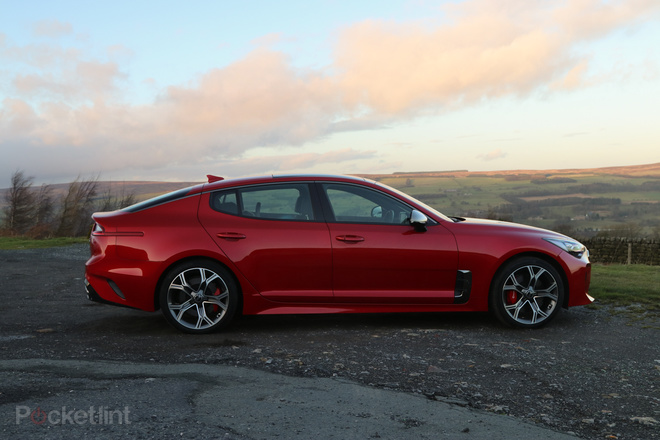
The Kia Stinger GT S is a bit of a contradiction. Considered in objective terms few people would be mad enough to buy one, given its old-school point of view. It has high CO2 emissions, a fairly high list price, and there’s a certain depreciation and tax burden after driving one away.
However, sometimes life doesn’t have to be all rational logic. Sometimes we make choices simply because something appeals on a visceral level, or represents a change to what we’ve had before. And it’s at this point that a Kia Stinger GT S really starts to carve out a role for itself. Rather like Lexus, Jaguar and Alfa are doing, it offers a genuine alternative to the obvious premium German brands’ way of doing things.
If you’re looking for something different, then the Kia Stringer GT S is a genuine contender. It’s got all round appeal, lures you in with its good looks, spoils you with its huge specification list, then finally amuses you with the way it drives. It made us feel alive. It reminded us that the German way isn’t the only way.
And so to our opening analogy: kimchee or sauerkraut? We’ll have the Korean fermented cabbage please. It might not sound like the choice to go for on name and description alone, but this Korean mean machine is a spicy and exciting alternative to the soggy pickles.
Alternatives to consider
Audi A5 Sportback
The A5 Sportback is new – and it’s the more obvious choice than the Kia. However, it’s not as well-equipped, you’ll have to upgrade to an S5 if you want a 3.0 turbo petrol engine, and it’s smaller. But it does feel notably more premium. And your neighbours will ask fewer questions. However, it’s simply less of a giggle to drive.
BMW 4 Series
The 4-Series is soon to be replaced, but it’s still fun to drive and offers some great engine options. In this way, it’s more sophisticated than the Kia and nearly as fun. However, BMW’s typically desirable options will take their toll on the list price.
(pocket-lint.com, https://goo.gl/gh5yEU)


